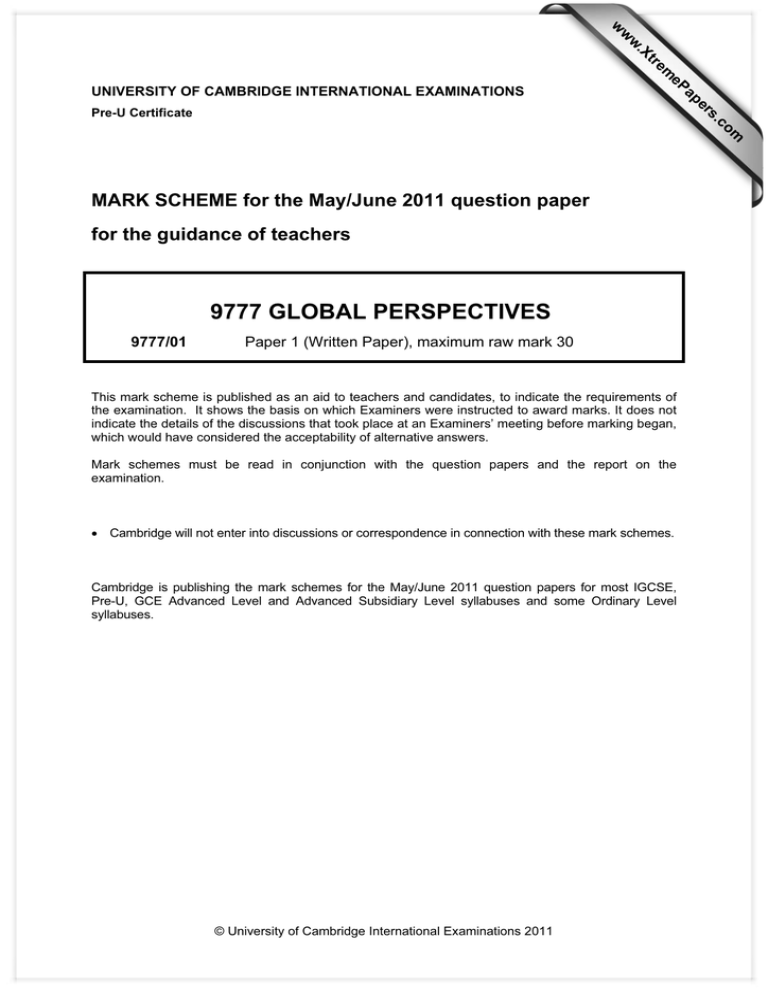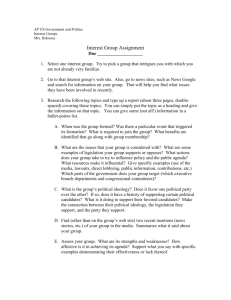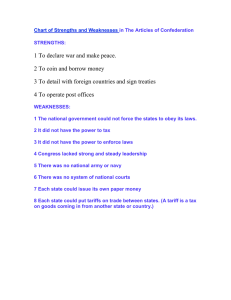9777 GLOBAL PERSPECTIVES MARK SCHEME for the May/June 2011 question paper
advertisement

w w ap eP m e tr .X w UNIVERSITY OF CAMBRIDGE INTERNATIONAL EXAMINATIONS s er om .c Pre-U Certificate MARK SCHEME for the May/June 2011 question paper for the guidance of teachers 9777 GLOBAL PERSPECTIVES 9777/01 Paper 1 (Written Paper), maximum raw mark 30 This mark scheme is published as an aid to teachers and candidates, to indicate the requirements of the examination. It shows the basis on which Examiners were instructed to award marks. It does not indicate the details of the discussions that took place at an Examiners’ meeting before marking began, which would have considered the acceptability of alternative answers. Mark schemes must be read in conjunction with the question papers and the report on the examination. • Cambridge will not enter into discussions or correspondence in connection with these mark schemes. Cambridge is publishing the mark schemes for the May/June 2011 question papers for most IGCSE, Pre-U, GCE Advanced Level and Advanced Subsidiary Level syllabuses and some Ordinary Level syllabuses. © University of Cambridge International Examinations 2011 Page 2 Mark Scheme: Teachers’ version Pre-U – May/June 2011 Syllabus 9777 Paper 01 Analysis and evaluation of arguments Critical analysis and evaluation of argument structure: to understand and apply the language of reasoning; • to analyse the structure of argument, by identifying the conclusion, reasons (premises), assumptions and any counter-argument; • to assess the technical strength/weakness of the argument by testing the acceptability, relevance and sufficiency of the premises to support the conclusion. Analysis and evaluation of contexts Situating the argument in its context: • identify and evaluate the use of key expressions and ideas, clarifying them as needed; • assess the credibility of sources (collected by the candidate); • identify alternative/rival perspectives and assess their relationship to the case presented; • identify desirable ends/outcomes from which to judge rival perspectives. • AO1 AO2 Presentation, communication and collaboration: • use language and other appropriate media to convey complex concepts and ideas with clarity; • establish a context or framework of understanding AO3 Communication sufficient for audiences to understand and respond to the presentation; • demonstrate ability to create a coherent and wellelaborated personal perspective and articulate its relationship to alternative perspectives. There is no requirement to use technical terms to access any level and candidates will NOT be rewarded for their use unless they link them directly to the demands of the question. © University of Cambridge International Examinations 2011 Page 3 1 Mark Scheme: Teachers’ version Pre-U – May/June 2011 Syllabus 9777 Paper 01 Study Document 1. Give three ways the author of Document 1 suggests the advantages of migration are limited. [3] Candidates are required to identify three ways that the author suggests the advantages of migration are limited and to achieve full marks it is essential that this is done. If only two ways are given, no matter how well they are developed, only two marks should be awarded. No set answer is expected, but candidates might identify issues such as: • The failure of remittances to reach the most needy. • Those who do migrate usually come from families with some resources therefore once again the poorest would be unable to take advantage of migration. • Some of the remittance money is ‘wasted’ on consumer goods. • Migration causes a brain drain from the country of origin. • The scale of remittances may have peaked and in some places is in decline. NB Only three marks are available and examiners should not expect detailed answers in order for candidates to achieve full marks. © University of Cambridge International Examinations 2011 Page 4 2 Mark Scheme: Teachers’ version Pre-U – May/June 2011 Syllabus 9777 Paper 01 Study Document 1. Assess the strengths and weaknesses of the evidence used in Document 1 to support the view that migrant workers bring benefits to the country of their origin. [6] Responses should focus on both the strengths and weaknesses of the evidence put forward in Document 1. • Level 1: it is likely that candidates will consider only either the strengths or weaknesses. • Level 3: candidates must consider both the strengths and weaknesses. • Level 2: there is likely to be imbalance, with most of the answer focusing on the weakness of the reasoning, although some may focus largely on the strengths. Sustained evaluation of strengths and weaknesses of the evidence. Level 3 5–6 marks Level 2 3–4 marks Level 1 1–2 marks Highly effective, accurate and clearly expressed explanation and reasoning; clear evidence of structured argument/discussion, with conclusions reached/explicitly stated in a cogent and convincing manner. Some evaluation of strengths and/or weaknesses of the evidence, but evaluation may focus on one aspect. Effective and generally accurate explanation and reasoning; some evidence of structured argument/discussion; conclusions may not be explicitly stated or link directly to the analysis. Little or no evaluation of strengths and/or weaknesses, although flaws, etc. may be identified. Level of communication is limited, response may be cursory or descriptive; communication does not deal with complex subject matter. Strengths of the evidence Candidates might point to the reliability of the figures provided by the World Bank about remittances compared to aid. They might suggest that the article uses evidence from more than one country and also point to the balanced nature of the argument, showing that not all the cash goes to the most needy. They might point to the nature of the source: Economist is a respected journal and is likely to produce a balanced argument. Weakness of the evidence Candidates might suggest that many of the comments are very generalised and lack specific support, e.g. much of the argument is based on assumption; no evidence is given to support the view that Poland and Mexico are big recipients, or that Africa is less likely to export migrants; no evidence is given to support the claims that remittances are efficient, or that aid is wasted; no evidence is given to show that remittances are spent on useful things like education and health; no evidence is given to justify the claim that migrants’ funds cut poverty in a household, etc. No set answer is expected and examiners should be flexible in their approach. © University of Cambridge International Examinations 2011 Page 5 3 Mark Scheme: Teachers’ version Pre-U – May/June 2011 Syllabus 9777 Paper 01 Study Document 2. Evaluate the strengths and weaknesses of the reasoning in Document 2. [9] Responses should focus on both the strengths and weaknesses of the argument put forward in Document 2. • Level 1: it is likely that candidates will consider only either the strengths or weaknesses. • Level 3: candidates must consider both the strengths and weaknesses. • Level 2: there is likely to be imbalance, with most of the answer focusing on the weakness of the reasoning, although some may focus largely on the strengths. Level 3 7–9 marks Level 2 4–6 marks Level 1 1–3 marks Sustained evaluation of strengths and weaknesses of reasoning, critical assessment with explicit reference to flaws and counter argument. Highly effective, accurate and clearly expressed explanation and reasoning; clear evidence of structured argument/discussion, with conclusions reached/explicitly stated in a cogent and convincing manner. Some evaluation of strengths and/or weaknesses of reasoning, but evaluation may focus on one aspect; assessment of flaws may be limited. Effective and generally accurate explanation and reasoning; some evidence of structured argument/discussion; conclusions may not be explicitly stated or link directly to the analysis. Little or no evaluation of strengths and/or weaknesses, although flaws, etc. may be identified. Level of communication is limited, response may be cursory or descriptive; communication does not deal with complex subject matter. Strengths of the reasoning Some might argue that as the information comes from the BBC web site it is a reliable source, written to inform, rather than written for a purpose. Some precise figures are provided to support the argument about the amount of money sent to Mexico and its importance for the Mexican economy. There is balance to the argument as it does acknowledge the view of critics. The article considers the wider impact of remittances, not just economic issues. There is detailed evidence from one region in Mexico to support the argument, with precise figures provided about population levels. Weaknesses of the reasoning Some might argue that the evidence used to reach its conclusion is based on the experiences of one country and within that only one area/region, which might not be typical. Evidence to support some of the claims put forward is either very general or is absent, for example no figures are given to show that the flow of remittances is greater than foreign aid or that the remittances impair local initiatives. Some might question the reliability of evidence given by the Mexican President during an election campaign, given its purpose. No set answer is expected and examiners should be flexible in their approach. © University of Cambridge International Examinations 2011 Page 6 4 Mark Scheme: Teachers’ version Pre-U – May/June 2011 Syllabus 9777 Paper 01 Study Documents 1 and 2. To what extent does Document 2 offer a different perspective from Document 1 on the impact of migrants? [12] Responses should focus on key reasons and evidence in both documents to compare alternative perspectives and synthesise them to reach a reasoned judgement. To assess whether Document 2 challenges or reinforces Document 1, candidates should consider not only the content of the Documents, but also critically assess the arguments put forward through a consideration of issues such as the nature of the passages, purpose and language. • Level 1: there will be very little comparison of the passages or evaluation and candidates may simply describe or identify areas of similarity and difference. • Level 3: candidates will reach a sustained judgement about whether the reinforcement or challenge is effective. In order to do this, they will have covered a significant range of issues and evaluated them clearly. • Level 2: there will be some evaluation and comparison, but it will be either poorly developed or limited in the areas covered. Level 3 9–12 marks Level 2 4–8 marks Level 1 1–3 marks Answers at this level will demonstrate a sustained judgement about whether the reinforcement or challenge is effective. There will be sustained evaluation of alternative perspectives; critical assessment with explicit reference to key issues raised in the passages leading to a reasoned and sustained judgement. Highly effective, accurate and clearly expressed explanation and reasoning; clear evidence of structured argument/discussion, with conclusions reached/explicitly stated in a cogent and convincing manner. Answers at this level will be more than just a comparison of the two documents; there will be some evaluation, but this will not be sustained and may focus on one perspective; assessment may not link key reasons and evidence clearly to the perspective or to the reasoned judgement. Effective and generally accurate explanation and reasoning; some evidence of structured argument/discussion; conclusions may not be explicitly stated or link directly to analysis. Answers at this level will compare a few points and there will be little or no evaluation of perspectives, although some relevant evidence or reasons may be identified. If there is any judgement it will be unsupported or superficial. Level of communication is limited; response may be cursory or descriptive; communication does not deal with complex subject matter. © University of Cambridge International Examinations 2011 Page 7 Mark Scheme: Teachers’ version Pre-U – May/June 2011 Syllabus 9777 Paper 01 Both Documents consider the economic impact of migrants on their former countries through the issue of remittances and conclude that they bring benefits. In both documents, this is supported by examples: in Document 1 on a nationwide scale, in Document 2 on a more regional/local scale. Therefore, candidates might argue that Document 2 reinforces Document 1. However, candidates might argue that because Document 2 concentrates solely on a local area that does not mean that similar benefits are being felt elsewhere and, therefore, that Document 2 does not reinforce the view. Document 1 presents a more balanced view, acknowledging that some nations are greater beneficiaries than others, most notably middle income nations such as Poland and Mexico. It might be argued that Document 2 reinforces this by concentrating on Mexico. However, Document 2 does not acknowledge points made in Document 1 such as the poorest countries do not benefit as much. Neither does it acknowledge other negative aspects of migration, such as the drain in skilled workers and the fact that remittances may have peaked and, to this extent, it thus offers a narrower perspective. The perspective offered in Document 1 is largely economic and, although Document 2 does reinforce many of the economic benefits put forward in Document 1, it considers other impacts (such as political) and therefore it does more than reinforce Document 1. It also considers how countries receiving the remittances have responded, an aspect not mentioned in Document 1. In undertaking these comparisons, candidates should also evaluate the evidence used to support the arguments put forward and go beyond a simple comparison of the content. No set answer is expected and examiners should be flexible in their approach. © University of Cambridge International Examinations 2011




